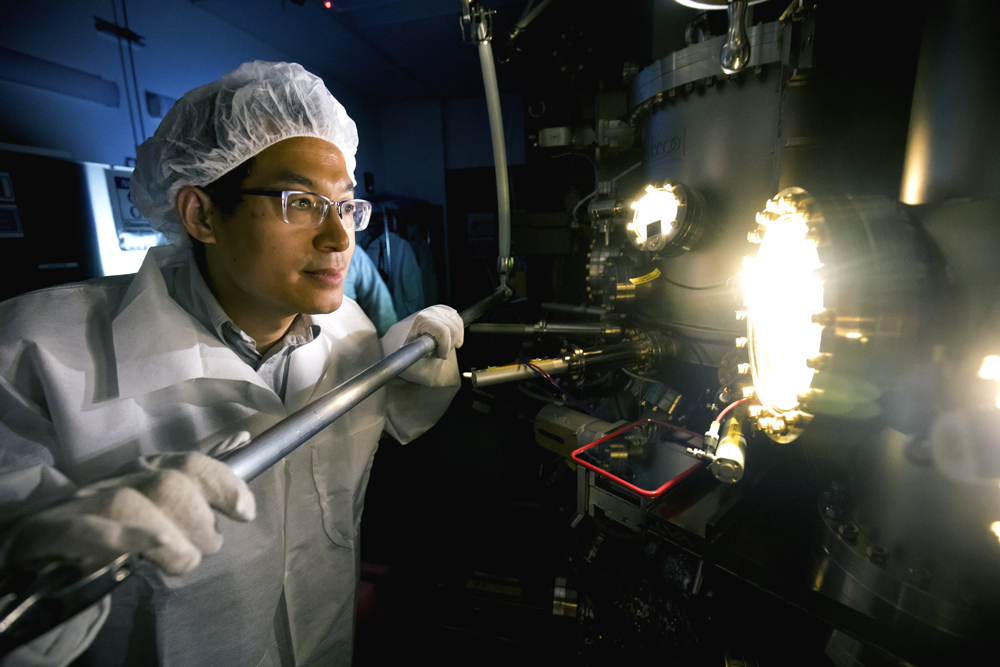News: Optoelectronics
7 October 2021
NSF awards Michigan $1.8m to develop room-temperature, controllable quantum nanomaterials
A team at the University of Michigan has been awarded $1.8m by the US National Science Foundation (NSF) for the project ‘III-nitride Monolayers and Extreme Quantum Dots’ to create quantum semiconductors that operate at room temperature. These could lead to the integration of quantum information and communications technologies with conventional computers — as well as advances in high-precision sensing and more sustainable ultraviolet (UV) lamps for sterilization and air purification.
“By demonstrating the controlled synthesis of such quantum nanomaterials, utilizing industry-standard processing tools, we hope to establish the material platform for scalable, next-generation quantum technology,” says Zetian Mi, professor of electrical engineering and computer science and principal investigator for the project.
The properties of gallium nitride (GaN) can be tuned by replacing some of the gallium with fellow group-III elements boron, aluminium and indium to create ‘extreme’ quantum-dot arrays which, because they are perfectly ordered and emit light identically, could offer new levels of control over quantum light emission and interactions between quantum dots used quantum bits (qubits).
So far, researchers haven’t been able to build perfectly ordered materials, controlling the location and size of each dot (necessary for controlling how the quantum dots interact when used as qubits). Mi believes that his team can overcome this through ultrahigh-temperature molecular beam epitaxy (MBE).

Picture: Zetian Mi, professor of Electrical Engineering and Computer Science, produces a sample in the MBE machine. (Image credit: Joseph Xu, Michigan Engineering.)
Because quantum nanomaterials differ from both classical semiconductors and conventional quantum materials, co-principal investigator Mackillo Kira (professor of electrical engineering and computer science) is leading the arm of the project developing a systematic quantum theory that will predict their behavior. This theory will enable researchers to figure out the available quantum states in the nanostructures, their light emission properties, and their capacity for quantum entanglement.
The light emission is useful for reading and writing quantum information, but it can also be used directly for efficiently producing UV light. At present, UV sterilization and air-purification technology typically relies on mercury lamps, which contain toxic materials and produce a lot of waste heat. Mi believes quantum nanomaterials could make UV-C lamps safer and 100 times more efficient than what is currently available.
“This material is ideally suited for UV optoelectronics, including UV LEDs for disinfectant applications,” Mi says. “Broadly speaking, 200-280nm is very important for disinfection purification applications. But there is no viable way to do that efficiently using conventional semiconductor technology.”
Beyond UV lamps, Kira is particularly interested in quantum computing and communications. “We’re talking about controlling the energy of light, and then what type of light is emitted which is also critical for quantum information applications, such as moving information long distances, quantum processing, information security, or highly sensitive sensing and detection.”
Mi’s group will use the theory to inform how they build the semiconductors to get the desired quantum properties. Then, researchers specializing in materials characterization will test the new materials to confirm their reliability and, by extension, the underlying theory.
“If we can make a few entanglement-based demonstrations, based on the new materials, that’s a big step forward,” says Kira. “That would be a founding moment of making semiconductors quantum-ready.”
In addition to Mi and Kira, key members of the team include co-principal investigators Theodore Norris (the Gerard A. Mourou Professor of Electrical Engineering and Computer Science) and Parag Deotare (assistant professor of electrical engineering and computer science), who will test and evaluate the materials. In addition, Manos Kiopakis (associate professor of materials science and engineering) will help with the design and modeling of GaN structures. Industrial partners Sandia National Lab and the Air Force Research Lab bring extensive experience in materials characterization.
The project is part of the Materials Genome Initiative, a federal multi-agency initiative for discovering, manufacturing and deploying advanced materials twice as fast and at a fraction of the cost compared with traditional methods.
Some IP related to this work was licensed to NS Nanotech Inc., which was co-founded by Mi. The University of Michigan has a financial interest in NS Nanotech.









